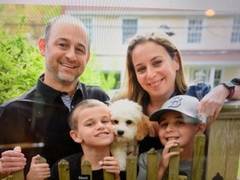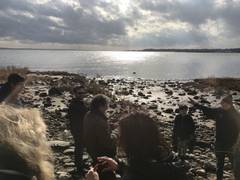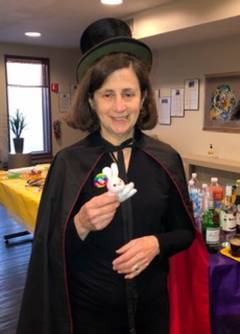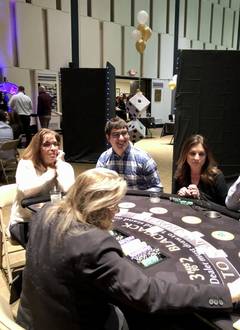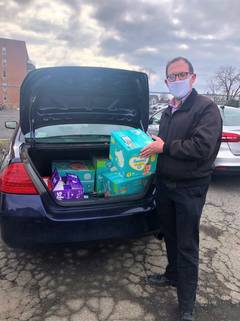Mas'ei 5779: Cities of Refuge
08/09/2019 03:04:41 PM
Aug9
| Author | |
| Date Added | |
| Automatically create summary | |
| Summary |
This week, the attorney general announced a change in the interpretation in US asylum law. As you may know, under federal law, someone seeking asylum must prove a credible fear of persecution in his or her home country based on religion, race, nationality, political opinion, or membership in a specific social group. Since 1985, immigration courts, which are part of the Department of Justice, have interpreted “specific social group” to include specific families, if membership in that family is the cause of the persecution.
In the case that prompted this ruling, a Mexican man claimed that his family was threatened by drug cartels because his father refused to let them operate out of his store. The attorney general reversed a lower court's ruling that his family counted as an identifiable social group, while leaving open future cases for people claiming asylum from countries where family-based clans really are distinct social groups and persecuted minorities.
This ruling is but the latest event in the ongoing argument about the nature of asylum laws and the limitations of their application. As Jews, we should be particularly sensitive to this issue, as the United States was a place of refuge for so many of our families. And as recently as the 1980s and 90s, 400,000 people from the former Soviet Union, many of them Jews, received asylum in the US .
I bring this up because our Torah reading this morning, from parashat Mas'ei, includes an early form of asylum or sanctuary for people in particular circumstances. As part of the preparations for entering the land, God commands the people to designate six cities of refuge.
These cities represent the Torah's attempt to contain an existing social institution, the blood avenger. In a situation where someone kills another person accidentally, in ancient times, the victim's family had a right, and was even expected, to avenge their relative's blood by killing the person whose actions led to the accidental death. Such extra-judicial killings took a bad situation and made it worse, by perpetuating the violence and bereaving another family.
So, the Torah mandates these six cities of refuge as a place where the person who committed manslaughter could flee. There, he or she would be protected from the vengeance of the family of the victim, and live in peace.
I've often wondered what it would be like to live in a city of refuge, a place where some significant portion of the population had killed someone, albeit by accident. How would it impact the life of the community? Did the people there discuss their experiences, or would they not want to bring it up? How would it feel to live in a community where lots of people had to uproot their lives in order to protect themselves from a vengeful relative?
The Talmud (Makkot 10a-b) clarifies that these cities were to be normal places, as much as possible. They were to be medium-sized cities with water sources and some kind of economic driver. The community was to ensure that these cities were viable places where someone could live for a very long time in safety. If a student of Torah had to flee, his rabbi would go with him so he could continue his studies, and if a rabbi had to flee, his students would join him. Yet, behind this veneer of normality, it would nevertheless be the case that many people in this community had experienced something traumatic�"the accidental taking of another life�"that had changed his or her life forever. All of these people walking around with guilt and fear�"surely this would affect the character of the place.
The Talmud also clarifies that these cities must be made easily accessible. The roads to these cities were to be well marked so someone who needed to flee could easily find them. Two sages would accompany someone on the way to the cities (Makkot 2:5) to protect them along the way. Furthermore, the accompaniment of these high-status people might prevent embarrassment, as it could look like that the accidental killer was engaging in Torah study rather than fleeing for his life.
Finally, the refuge was not necessarily permanent. Anyone who had committed manslaughter was to stand trial to determine what had happened (Numbers 35:12), rather than be killed extra-judicially by a vengeful relative. Only once a court determined that the person had committed an intentional act of murder would the victim's relative have the honor, if you can call it that, of executing the court's punishment. But, if the court found that the death had occurred accidentally, the killer would be protected from the blood avenger only within the city of refuge. Were he to leave it, he would be fair game.
All of this is further evidence that this law is the Torah's attempt to rein in the existing social expectation that the blood avenger has the right and the obligation to kill the person who had killed his relative.
The picture that emerges from all of these details is that the Torah's vision of society includes easily accessible protection for people who have to flee for their lives. They are entitled to safety and to something resembling a normal life. Nor does the Torah demand that these individuals be perfect�"after all, they had all killed someone, albeit by accident.
Yet nonetheless, their lives were at risk, so the Torah develops a social institution to protect them. They are provided with a safe, normal place to live, so that they can come to terms with what had happened and get a fresh start in a new community.
The problem of people whose lives are at risk seeking safety obviously remains with us today, as millions of people around the world have been displaced by war and famine and disaster. In recent years, a growing stream of people, including families and children, have made the dangerous journey toward this country in order to seek safety from oppressive governments or gang violence. The people seeking asylum in this country, such as the Mexican man whose case prompted the recent Justice Department policy change, are often fleeing dangerous situations where corruption and gang violence have destabilized their communities.
Obviously, this remains a hotly contested political issue, and I'm not here to take a stand on the right way forward. But, the situations of the people seeking asylum today remind me of the situation of the manslaughterer in the Torah, the situation of the people who, through no fault of their own, had to flee for their life. As the Torah saw it, such people deserved a fair hearing and safe refuge from those would kill them. As it was then, so may it be in our day.
Fri, October 17 2025
25 Tishrei 5786
Photo Gallery
Photo Albums
Fri, October 17 2025 25 Tishrei 5786
Upcoming Events
All Events
-
Tuesday ,
OctOctober 21 , 2025Women's Rosh Chodesh Group
Tuesday, Oct 21st 12:00p to 1:30p
New Women's Rosh Chodesh Group Tuesdays, 12:00-1:30pm Gather with Cantor Sklar and KTI friends at the start of each month of the Hebrew calendar to learn about the themes and traditions of the coming month. Learn from each other, learn more about each other and better understand the women within our tradition. Enjoy music and lunch together! Please a dairy or parve lunch to enjoy at noon, followed by the discussion at 12:30pm. KTI will provide drinks and dessert. RSVP Appreciated -
Wednesday ,
OctOctober 22 , 2025Rabbi, May I? Modern Responsa
Wednesday, Oct 22nd 10:00a to 11:30a
Wednesdays, 10 - 11:30 AM, KTI Library Ever since Abraham’s famous argument with God, Judaism has been full of debate. Moses and Korah, David and Nathan, Hillel and Shammai, the Vilna Gaon and the Ba’al Shem Tov, Spinoza and the Amsterdam Rabbis . . . the list goes on. No wonder that Judaism cherishes the expression machloket l’shem shamayim, “an argument for the sake of heaven.” Beyond their historical importance, what makes these disputations so compelling is that nearly all of them, regardless of their epochs, are still being argued. The parade of characters spanning three millennia of biblical, rabbinic, and modern disputation reflects the panorama of Jewish history with its monumental political, ethical, and spiritual challenges. This series will examine Jewish responses to exile from the biblical period to our modern day. Considering texts from all genres of Jewish literary creativity, we will explore how the realities and iterpretaions Join as we re-open these timeless debates that lead us to the core of 3,000 years of Jewish conversation. • Justice: Abraham vs. God (October 19) • Holiness and Authority: Moses vs. Korah (November 9) • Inclusion: The Five Daughters vs. the Twelve Tribes (November 30) • Accountability and Morality: David vs. Nathan (December 21) • Resistance: Ben Zakkai vs. the Zealots (January 18) • Law: Hillel vs. Shammai (February 15) • Spirituality: The Vilna Gaon vs. the Baal Shem Tov (March 15) • Boundaries: Spinoza vs. the Amsterdam Rabbis (April 19) • Religious Evolution: Geiger vs. Hirsch vs. Frankel (May 10) • Zionism: Herzl vs. Wise (May 31) -
Wednesday ,
OctOctober 22 , 2025Wrestling with God
Wednesday, Oct 22nd 8:00p to 9:30p
Wrestling with God Wednesdays, 8-9:30 PM Congregants’ homes TBA We need to talk about God. And about how we talk, and don’t talk, about God. It’s a big topic, maybe the biggest. This offering invites adult learners into compassionate inquiry, deepening their relationship to Jewish text through collective exploration. Using the album s*ngs ab-ut g?d [https://open.spotify.com/album/6JEY2AN6awAxNfWwmXX460] by Jewish educator Eliana Light as a starting point, this series blends music, Hebrew text study, and open-ended questions to help participants examine their own connections to the divine. This is sacred work. It’s not about getting it right. It’s about showing up with curiosity, humility, and a willingness to join the long lineage of Jews who wrestle with God. Each session stands alone, but we’d love to have a consistent group as much as possible. Dates: September 10: skyman October 22: shadows November 19: in the silence December 10: if only January 21: lead me back February 11: three steps March 11: beyONEd April 29: the mountains May 20: the name June 17: I rise -
Thursday ,
OctOctober 30 , 2025Coffee with the Rabbi
Thursday, Oct 30th 8:00a to 9:00a
Start your morning with some caffeine and casual or meaningful conversation! Join Rabbi Goldberg for a Coffee Chat! Stop by Rye Ridge Starbucks any of the following Thursdays, between 8-9am: June 12 and 26 July 10 and 24 August 7 and 21 September 4 and 18 October 16 and 30 November 6 and 20 December 4 and 18 -
Saturday ,
NovNovember 1 , 2025Dror Israel Shabbat
Shabbat, Nov 1st 11:30a
Dror Israel Shabbat Dror Israel’s Mirit Sulema, along with two leaders of the Arab Youth Movement NOAL, Tal Tunik and Shadi Habiballa, will speak during a Kiddush lunch about their important work with Arab Israeli youth and bringing Jewish, Arab, and Druze youth together. Saturday, November 1st, approx. 11:30am KTI Social Hall "We eat together, laugh together. We talk about what we think of each other, and what will help bring peace.” RSVP Appreciated
Privacy Settings | Privacy Policy | Member Terms
©2025 All rights reserved. Find out more about ShulCloud

